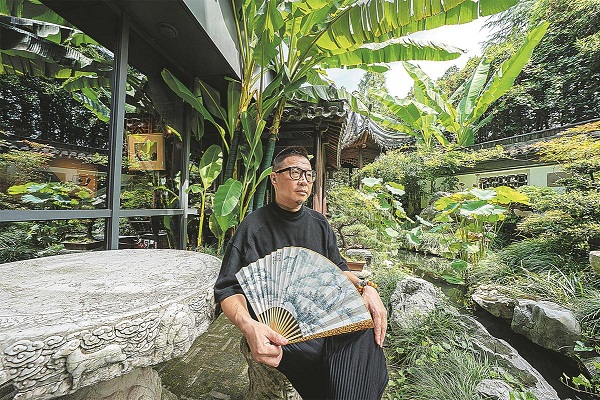 |
|
Yin Hao, designer and owner of the Ming Che Shan Fang garden, sits on a stone bench in the garden. GAO ERQIANG/CHINA DAILY |
Cai said Chinese classic gardens reflect different cultures as well. For example, Suzhou gardens were usually built by literati who abandoned their career of being officials in government and lived in seclusion in rural areas. Gardens were a sanctuary for them, simple yet warm. However, gardens in Jiangsu province's Yangzhou, which is home to rich salt merchants, features extravagant construction and reflected the merchants' attitudes toward luxury and enjoyment.
"People's appreciation of beauty is evolving as the world is developing. Creating a garden that looks the same as a traditional one is not necessary, and instead, we can adapt to local conditions and combine the living habits and aesthetic of people today, while incorporating major elements of classic gardens," Yin explained.
"It's a place to have a glimpse of Ming and Qing furniture and local gardens," says Ma Shanglong, a writer who visited the garden. "I also admire the owner's design to build a Jiangnan style garden within the steel structure of a factory. It is a place worthy of several visits."
Valuable antiques enrich the culture of the garden. It includes a 3-meter long table made of Huanghuali wood-the main material of hardwood furniture from the Ming and Qing dynasties-from the late Qing Dynasty (1644-1911) Yin collected from Zhejiang province's Huizhou. The table was used by people from ancient China to write calligraphy on.
The wooden windows of the ancient bungalows collected from Shandong province are used to borrow scenery from one room to another.
The garden has also been where exhibitions are held for free by Yin's friends, as an art appreciation and cultural exchange platform. So far, it has showcased exhibits such as Chinese brushes and ink, fans, paintings and calligraphy. "Some visitors hope to buy the antiques, but I have no plan to sell them and don't know the current prices. Some may be worth tens of millions yuan if they are auctioned," Yin said.
"They are all valuable cultural antiques in need of intensive care which will last forever if protected well, and I'd love to protect them."
Home to many tourism attractions like Ming Che Shan Fang, Shanghai attracted 8.83 million tourists during the Mid-Autumn Festival and National Day holidays last year, and gained 13.5 billion yuan ($2.09 billion) in tourism revenue.

